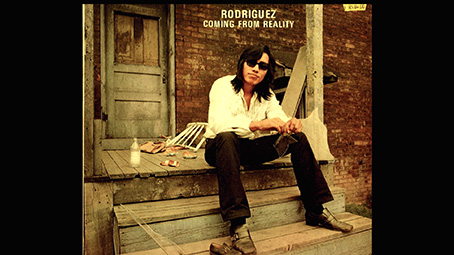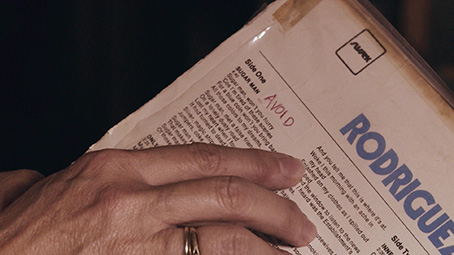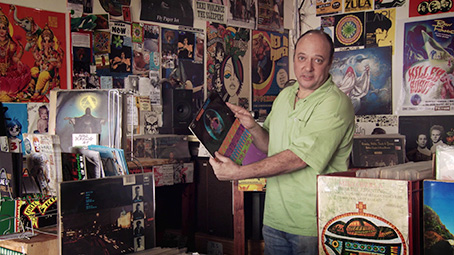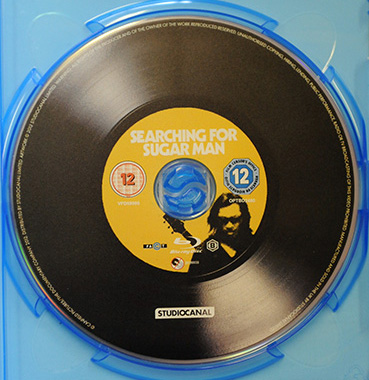| |
"I thought it was evident that the story was good – had it been conceived by a screenwriter you would have thought that it was too much, too unbelievable to make sense. I thought the fact that this really happened – and the way it happened – would be enough to attract investors. But in the end the story attracted everyone but the investors. Maybe it was because I was a new director. I was so passionate about it that I didn't receive a salary for three years, I just worked on the movie, but there was a point where I had to find a proper job and I thought I would have to give up." |
| |
Director Malik Bendjelloul |
| |
Cause they told me everybody's got to pay their dues
And I explained that I had overpaid them
So overdued I went to the company store
And the clerk there said that they had just been invaded
So I set sail in a teardrop and escaped beneath the doorsill
Cause the smell of her perfume echoes in my head still |
| |
Cause - Sixto Rodriguez |
It's not often I kick off a review by suggesting you read no further, but that's what I'm proposing here. It all depends on how much you know about the film and its subject matter. If you've never heard of singer-songwriter Sixto Rodriguez and read nothing about Malik Bendjelloul's captivating documentary, then the best advice I can give is to stop reading now, avoid contact with any other reviews and don't even look at the sleeve of this disc. Just rent or buy the film or seek out a screening and sit down and watch it. You won't regret it. Director Bendjelloul assumes a lack of knowledge on the part of the viewer and structures his story accordingly, and it really is worth letting him tell it his way if you can. And in order to discuss what's so good and what is a just little misleading about the film, I've got to reveal things that are far better discovered by just seeing it.
Last warning. Seriously. Well, almost.
OK, if you're still with me then I assume you've already seen the film or read all about it and are thus not going to shout at me for spoiling the mid-film reveal. And the thing about that is...

Hang on a mo, I'm getting ahead of myself. Protocol dictates that I outline the plot for those who have chosen not to heed the above warning. There are no major spoilers in what immediate follows, so you still have to the end of the next paragraph to bail out.
Back in 1968, Detroit-based American folk singer-songwriter Sixto Rodriguez was talent-spotted by music producers Dennis Coffey and Mike Theodore, who signed him to Sussex Records in the belief that he had the potential to be the next Bob Dylan. In 1970, Rodriguez recorded his first album, Cold Fact. It didn't sell. A year later, his second album Coming From Reality was similarly unsuccessful, and he was promptly dropped from the Sussex label. Unbeknown to him, his music had found a far more appreciative audience in apartheid South Africa, particularly with the more rebellious liberal white youth. They bought and bootlegged his records in their droves, making him one of the country's most famous musical artists. But the closed nature of South African society in these pre-internet days ensured that information flowed freely in neither direction, and to his new legion of fans, Rodriguez was an enigma. All anyone seemed sure of was that he had killed himself in an on-stage suicide. The stories differed about how this had happened, some claiming that set himself on fire, others that shot himself in the head. Fascinated by the man and his music, record shop owner Steve 'Sugar' Segerman and music journalist Craig Bartholomew-Strydom took it upon themselves to find out more about their favourite singer and discover the true story of how he died.
All of which makes for a compelling first half in which the details of Rodriguez's discovery, music, failure to crack the domestic market and his popularity in South Africa unfold in the manner of a detective story. Technically it's by the documentary book, and there are times early on when its blend of talking head interviews, animated inserts, location footage and faked archive material have an almost mockumentary ring, particularly given the almost mythical nature of the singer under investigation. What grounds it in reality is Rodriguez's music; his voice is just too distinctive and his songs too damned good to be constructed fakery. The twist, as those who know the story will know, is that far from killing himself, Rodriguez is still very much in the land of the living, having returned to manual labour after being dropped by Sussex Records, where he remained blissfully unaware of his South African success.

The difficulty for the first half is that it's structured around the presumption that we don't know this in advance, a reasonable expectation when the film first screened at Sundance but increasingly unlikely in the wake of the subsequent critical and audience enthusiasm for both the film and Rodriguez's music. Almost all of the articles I read when preparing for our cinema screening revealed what Bendjelloul spends 42 minutes trying so hard to conceal; even the sleeve of this disc falls foul of this, with the carefully worded synopsis undermined somewhat by the announcement beneath it that Rodriguez himself is on the commentary track.
However, as someone well aware of this before I first saw the film, I still found the first half enthralling viewing. The investigation itself is littered with interesting stories and it's fun watching people asking questions to which you know the answer and wondering just how they will unravel the mystery. The length of this build-up (which never feels long) also ensures that our anticipation mirrors that of our two intrepid investigators, and brings a charge of excitement to Rodriguez's journey to South Africa to play a concert for five thousand wildly enthusiastic fans. When he finally hits the stage the effect is exhilarating, not least because Rodriguez himself – humble about his talent and completely unfazed by his sudden exposure to fame – is one the nicest people ever to grace the music business.

Not all is quite what it seems, however. In his desire to create a true life fairy-tale, director Bendjelloul chooses not to reveal that prior to his triumphant South African tour, Rodriguez had also embarked on two tours of Australia, where his music had also found an appreciative audience, albeit not on the scale of his South African fandom. The Australian record label Blue Goose Music even released a compilation album, At His Best (which went platinum in South Africa), which was followed with Alive, a live album of songs from his 1979 tour. It's a 'print the legend' deception that sneakily avoids tarnishing the the film's obscurity-to-fame story by keeping a few details quiet, a near-impossible task in an age when information on almost anything and anyone is just a few mouse clicks away.
But in the end this omission does no serious harm to what is a hugely enjoyable and uplifting tale that plays perfectly on our innate desire to see the wrongs of past years righted. And even without the extraordinary story at its core, the film would still come recommended for its key role in getting the sublime, soulful music of Sixto Rodriguez the widespread recognition it has so long deserved.
As with many a documentary exploring past events, the newly shot footage is intercut with material sourced from and shot on a variety of formats, including 8mm, DV, monochrome video, broadcast HD and even an iPhone. The new footage was shot on HD on a Sony EX1, the first prosumer camcorder to carry the CineAlta 24p brand and yours for a little under £5,000. The results, thanks in no small part to cinematographer Camilla Skagerström's impressive lighting camerawork, are clean and detailed and boast a frequently spot-on contrast range that nails the black levels and avoids burned-out whites. A very solid transfer.
While the HD picture is nice, in a film in which music plays such a crucial role it's the soundtrack that really matters, and the two tracks here do not disappoint. You can choose between Linear PCM 48 stereo and DTS-HD Master Audio 5.1 surround (for which you'll need an HD compatible amp) and both are impressive, specifically for the clarity and richness of the songs, which sound lovely on both tracks. As is often the case, the 5.1 track is slightly richer and more inclusive than the stereo and makes subtle but effective use of the surrounds for music and location effects.
There's also an audio description track and optional English subtitles for the hearing impaired.

I'm also going to give a small shout for the in-film menus (a feature unique to Blu-ray discs), where the scene selection is designed as taped-up snapshots and the soundtrack options are shaped like audio cassettes. I also got a small thrill from a disc designed to look like an LP record (look it up if you're too young to know what that is), an effect tarnished slightly by a clumsily located Studiocanal logo.
Commentary by director Malik Bendjelloul and Sixto Rodriguez
See what I mean? When your disc includes an extra whose mere presence confirms that Rodriguez is alive, then no carefully worded synopsis is going to effectively disguise that fact. But if you have seen the film you'll be glad this is here, as it ranks as one of the most enjoyable and informative commentary tracks I've heard in a long while. There's something of a happy mismatch in the pairing here, with Bendjelloul's hyperactive enthusiasm nicely counterbalanced by Rodriguez's easy-going calm, when he can get a word in edgeways, of course. I'm doing Bendjelloul a disservice here, as his excitement at the project and its subject matter quickly proves infectious, and the background he provides on the project as a whole and the shooting of individual scenes is consistently fascinating and often entertaining: the Rodriguez tour poster in the background of a first-half interview that had to be painted out to avoid spoiling the mid-film reveal; the need to coach interviewees to talk in the past tense for the same reason; the amateur concert footage that turned up too late to be included in the film; the faked archive footage that was shot on Bendjelloul's iPhone and processed in-camera with an 8mm film-look app; the interview he bagged with Rodriguez's workmate Jerome at 1.00am for the price of a pint; the series of chance events that allowed him to grab an interview he wanted in Palm Springs... the list just goes on and on and includes a number of other intriguing stories that didn't make their way into the final cut. Seemingly reluctant to talk at first, Rodriguez becomes more vocal as the film progresses and what he has to say is always worth hearing, particularly his comments on former colleagues, his family and his political activism. His down-to-earth outlook and gentle delivery at one point amusingly undercuts Bendjelloul's beguiling use of side-on tracking shots of Rodriguez walking the Detroit streets to visualise his reputation as a 'wanderings spirit'. "You like walking, right?" Bendjelloul asks enthusiastically, to which Rodriguez calmly responds, "Well I don't have a car, so I have no option."
Making-of documentary
Shot, directed and edited by Ed Perkins, this is a smartly assembled look at the process by which the film came together, driven along by Bendjelloul's nervous energy and enthusiasm, with contributions from producer Simon Chinn and (very briefly) cinematographer Camilla Skagerström. Concise, entertaining and busy with information, there is some inevitable overlap with the commentary track, but there is still plenty of revealing material here, plus snippets of interview footage and of Rodriguez himself that are not in the main feature. What really comes across is just how driven Bendjelloul was to make this documentary, investing everything he had in what proved to be a four-year project, and when unable to afford to hire and editor or composer, he taught himself to do both jobs, editing and scoring the film on his laptop using Apple's Final Cut and Logic Express software. Really good stuff, though for maximum effect I'd watch it before the commentary.
Trailer (2:22)
A well cut trailer and a good sell for the film, but while it doesn't exactly give away the midway twist, it certainly drops enough hints for the attentive to work it out for themselves.
Guilty of omissions, perhaps, but Searching for Sugar Man still tells an remarkable story in bewitching fashion, aided immeasurably by a distinct visual style and a man whose talent, modesty and easy affability make it easy to cheer for his triumphant if belated international success. Studiocanal's Blu-ray has only two extra features of note, but both are first rate, and the picture and sound quality are all you'd hope for. Definitely recommended.
|